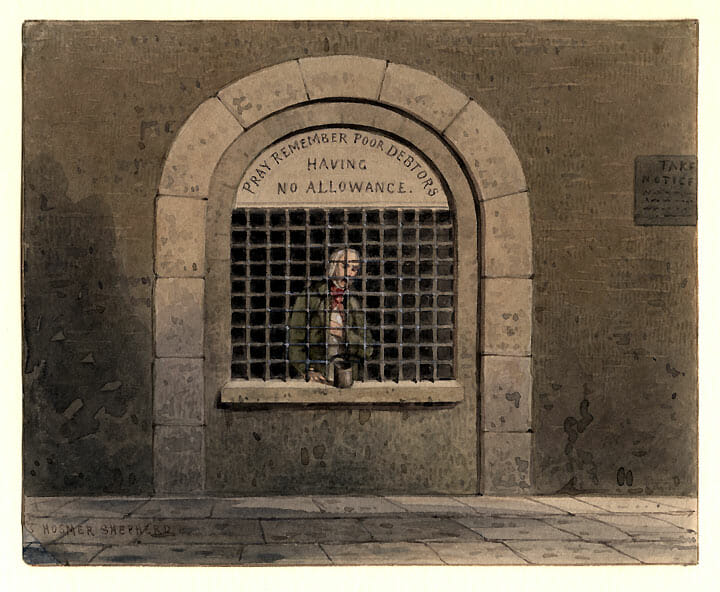Debtors’ Prisons and Other Catastrophes

George Bernard Shaw became a socialist by reading a book. Oddly enough, the book that converted him was not a political tract, but a novel: Charles Dickens’s Little Dorrit. Shaw regarded Dorrit as “a more seditious book than Das Kapital.” The novel centers around the reviled institution of the debtors’ prison, a subject that haunted Dickens (his chronically impecunious father had served time in one).
Once considered a creepy Victorian relic that we’d mercifully reformed out of existence, debtors’ prisons have now made a major comeback in our own time.
A particularly cruel debtors’ prison story made national headlines just last week. A mother of seven from Reading, Pennsylvania named Eileen DiNino was found dead in her prison cell. DiNino, age fifty-five, was serving a two-day sentence because she couldn’t afford to pay the $2,000 in fines and court costs she’d racked up stemming from her kids’ truancy cases.
DiNino was unemployed and living at the home of a family member with four of her kids, the youngest of whom was twelve. It’s unclear what caused her death, but according to medical reports, she was taking prescription medications for high blood pressure, depression, and anxiety. That she had been on those kinds of meds is understandable. If you had her life, you’d probably be stressing the hell out, too.
Nevertheless, the judge who heard Eileen DiNino’s case, Dean R. Patton, sentenced her to forty-eight hours in the slammer for her unpaid debts to the state. He did so “reluctantly,” he later told the Associated Press. In an interview, Patton described DiNino as “a lost soul.” She had often shown up in court without the requested documents, looking “unkempt,” he said. Yet when she reported to court to surrender for her jail sentence, she was “smiling” and looked “clean and neat.” “She had on clean sweatpants, had combed her hair, and had tape holding her glasses together,” the AP reported.
It’s that detail about the taped-together glasses that kills me.
Eileen DiNino fell victim to several interrelated public policy catastrophes that have been inflicted on the poor in America in recent decades. One is the growing use of increasingly hefty fines and court fees throughout our criminal justice system. A recent in-depth study by NPR found that “defendants are charged for many government services that were once free, including those that are constitutionally required.”
In over forty states, previously-free services like a public defender, jail and prison room and board, probation and parole supervision, and electronic monitoring devices can now be charged to defendants and prisoners. Defendants can be charged for their own court-case-related DNA tests and substance abuse treatment. There are also various administrative court costs. DiNino, for example, had been billed “$8 for a ‘judicial computer project’; $60 for Berks County constables; $10 for postage”—and that was just for one case.
These fees make a mockery of the principle of equal justice under the law. An affluent defendant might regard a fine as the equivalent of pocket change. But Eileen DiNino told the court that she couldn’t afford to pay her fines and “still keep the lights on in her house and feed her children.”
The United States had never imposed these types of fines until relatively recently. The NPR report noted that, although state and local governments started instituting these fees during the tough-on-crime 1970s, it wasn’t until the 1980s and the War on Drugs era that they became common. The purpose of the fees wasn’t just punitive; it was also practical. Local governments, struggling with austerity-starved budgets, were desperate to drum up new sources of revenue. The U.S. Justice Department estimated that in 1991, 25 percent of inmates left prison owing fees; currently, that percentage is thought to be in the 80 to 85 percent range.
In 1983, the Supreme Court ruled that it’s unconstitutional to send someone to jail for being too poor to pay such fines. But the courts have tended to interpret the decision narrowly, leaving the poor with few legal protections.
In many states, poor people are forced to pay their legal fees to predatory private probation companies that gauge them with high interest rates and tack on additional charges. A recent report by Yes! magazine cites the case of an Alabama man living on $800 a month in disability payments who, over the years, accumulated close to $9,000 in debts from just two traffic violation fines. Those who fail to keep up their payments risk not only a jail sentence but other serious consequences as well—such as the loss of a driver’s license and welfare benefits.
Eileen DiNino’s crime, besides being poor, was having kids who skipped school. Within the last decade, the insidious practice of using the criminal justice system to deal with truancy issues has become widespread. As a 2012 Atlantic story reported, for local governments across the country struggling with scarce resources, “truancy fine factories” have become cash cows.
At the same time, economic pressures at home also contribute to truancy problems, when kids act out as their preoccupied parents cope with unemployment and trying to keep a roof over their head. Women tend to be disproportionately affected by harsh anti-truancy policies; two-thirds of the people jailed for truancy fines in the county where Eileen DiNino died have been women.
There is little evidence that a policy of criminalizing truancy improves educational or other outcomes for the children it’s supposed to help. But it certainly does succeed in creating more misery for a class of people who already have far more than their share.
Judge Patton says he’s “lost sleep” over Eileen DiNino’s death.
I would too, if I were him.